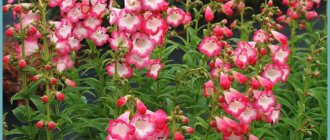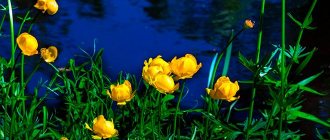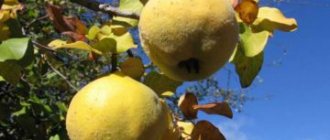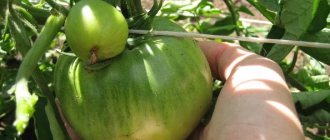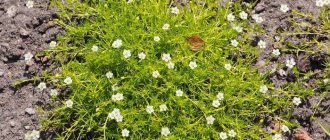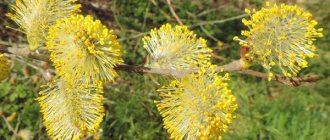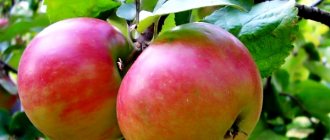Gumi (Elaeagnus multiflora) or Loch multiflora is a shrub that belongs to the genus Loch (Elaeagnus), included in the family of the same name Loch (Elaeagnaceae). The native territories of this representative of the flora are considered to be the lands of East Asia: Chinese, Japanese and Korean, with a temperate climate. In Russia, they recognized and began to cultivate this unusual berry plant after the Japanese brought it to Sakhalin before the outbreak of hostilities in that region. The genus Loch, according to various sources, unites 50–70 plant species. However, the variety of the multifloral sucker still does not have many varieties, since it is not very well known among gardeners, although its fruits are very useful.
| Family name | Lokhovye |
| Growth cycle | Perennial |
| Growth form | Shrub or small tree |
| Reproduction type | Seeds, cuttings, layering |
| Transplant time to the garden | Mid spring |
| Disembarkation scheme | 2 m is left between the seedlings |
| Substrate | Lightweight yet nutritious |
| Indicators of soil acidity, pH | 6.5-7 (neutral) |
| Lighting level | Sunny location |
| Recommended humidity | Regular, but moderate watering is required, in the heat - do not allow the soil to dry out |
| Special Requirements | Not pretentious |
| Height indicators | 1.5 to 3 m |
| Color of flowers | White, cream, pale pink |
| Inflorescences or type of flowers | Solitary |
| Flowering time | Mid to late May |
| Color and shape of berries | Bright red, oblong-oval |
| Fruiting time | From late June to early July |
| Decorative period | Spring-summer |
| Places of application | Bonsai hedge |
| USDA zone | 2–6 |
The scientific name in Latin was given to the plant from the Greek word "elaiagnos", consisting of two parts "elaia" and "agnos", which translate as "olive" and "Abraham's tree". This is due to the fact that the fruits with their outlines resemble small olives, and the foliage is also similar in its features to the leaves of Vitex sacred or Chaste (Vitex agnus-castus). The second name - "gumi" (Goumi) or "gummi" was given due to natural growth, since China and Japan are considered native lands, the Japanese name sounds "natsu-gumi", where the first part "natsu" means "summer" , the second means "cherry". In those parts, the shrub is called "Japanese cherry" or "silver cherry". The people can hear the term "miracle berry".
Basically, all varieties of multiflower sucker have the shape of a shrub, occasionally being a small tree. Plant height can vary in the range of 1.5–3 m, while the crown is almost 2.5 m in diameter. The root system is rather highly branched and is located close to the soil surface. It grows so widely that if you make a projection of the crown onto the soil, then the root shoots can be found 1–1.5 m from this place. The root system of gumi has one important feature - root nodules are formed on the roots, which contribute to the fixation of nitrogen in the atmosphere. This process is possible due to special bacteria living in the nodules.
At the same time, at any time of the year, the bush attracts the eye with its outlines, but it is especially beautiful during months of active growth, flowering and fruiting. The outlines of the bush can be very different: from very spreading to compressed pyramidal.The color of annual branches is pale brown, adult shoots become grayish brown. Over time, the branches acquire a strong branching, and thorns grow on them. Gumi varieties are distinguished by the presence of more or less thorns on the shoots, but there are garden forms completely devoid of such "decoration". After planting, for the first few years, the growth of the multiflorous sucker is very slow, but then in a year the shoots are added in height of 50–80 cm.
The leaf plates of Elaeagnus multiflora in the upper part have an elliptical or oblong shape, the foliage is entire. The leaves have a bright green saturated hue. The leaf plate is dense, there is pubescence of silvery hairs, so the color of the deciduous mass takes on a silvery-metallic sheen. On the back of the leaf, you can distinguish scales of a dark brown color. Although the plant has all the signs of an evergreen, in our latitudes the foliage will be shed with the arrival of autumn. It happens that even in the summer months the bush sheds all the leaves and goes into a dormant state.
When gumi blooms, fragrant flowers with cream petals open in the form of earrings. Flowers are bisexual. The corolla of the flower is elongated, resembles a bell in outline. Because of the flowers, the plant is considered an excellent melliferous plant, as they fill with nectar and spread a sweet, fragrant aroma around. This smell serves as a bait for pollinating insects, mainly bees. The flowering period stretches from mid to late May.
After pollination, after 45 days, drupes ripen in place of flowers. The berries are bright red in color and hang from twigs on elongated stalks. The fruits of the multifloral sucker are juicy and very useful, with a slightly tart, sour-sweet taste, but as they ripen, the astringency gradually goes away. Different types of gumi have different flavors, they can resemble cherry, dogwood, pineapple or apple. The size of the berries is comparable to a large cherry and does not exceed 1.5–2 cm in length. Their shape is oblong-oval, rather similar to dogwood. The surface of the bone is grooved. The shade of the berries, as they begin to ripen, gradually changes from green to yellow and then red. Fruits fully ripen from late June to early July. Fruits from the branches do not crumble by themselves.
And although on the territory of Japan gum is considered to be a berry that brings health and longevity, quite a few varieties have been bred. Apparently because Japanese gardeners do not try to grow multiflora with large fruits, since the medicinal qualities of berries are important to them, which they try to preserve as much as possible. The timing of the ripening of the fruits, their color, as well as the dimensions of the bush itself are not important. This difference is not associated with a long-cultivated berry plant.
Since the multiflorous oak tree is quite frost-hardy and its cultivation is not too difficult, from such bushes you can not only get a lot of nutritious fruits, but also form a hedge. Used in rooms as bonsai.
Rules for growing gumi - planting and caring for a personal plot
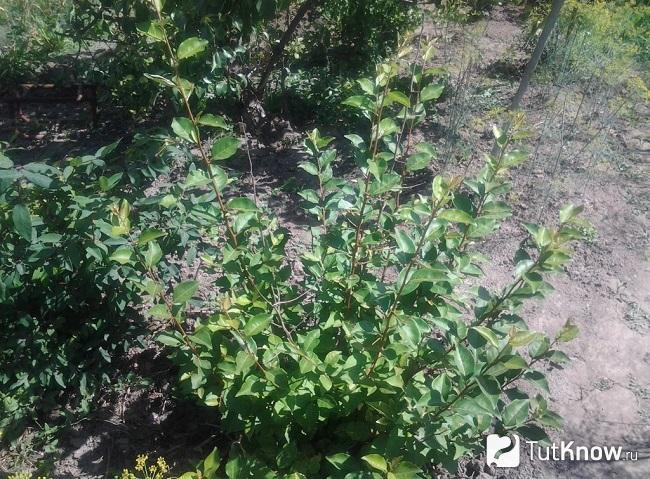
- Shrub planting location.
Since the plant prefers open areas in nature, it is better to select a place with a high level of illumination, this will be the key to obtaining a bountiful harvest of berries. It is important that moisture stagnation from melting snow or prolonged rains is excluded. Better to find a location protected from cold winds and drafts. - Soil for planting gumi.
In order for the shrub to grow well and please with abundant fruiting, it is recommended to select a moist substrate with neutral acidity (pH - 6.5-7). If the acidity on the site is higher, then about a year before the multiflower goose is planted in the garden, liming the soil should be carried out. All preparations must be done in the fall.Important! Depleted substrates and wetlands are categorically unsuitable. - Planting gum
it is performed in the spring, preferably in March-April, but the pits are prepared in the fall. Before digging, it is recommended to mix about 300 grams of double superphosphate, 700 grams of wood ash and 30 kg of organic matter into the soil before digging. You will also need to add top dressing to the hole itself before planting, gardeners use superphosphate at the rate of 100 grams per 1 m2. In the hole, the seedling of the multifloral sucker is set to a depth of about 8 cm. It is important to place the bush strictly vertically. It is recommended to use 1-2 year old seedlings. It is necessary to place a couple of plants nearby so that they are pollinated, since the flowers of gumi are dioecious. At the same time, the distance between the seedlings is maintained at about 2 m. In order to stimulate the branching of the shoots, the entire above-ground part of them is cut off, leaving only 70 cm from the soil surface. Important! It is immediately required to choose the correct location of the shrub, since the transplant is extremely negatively transferred to them. The depth of the planting hole does not depend on the size of the sucker seedling. It is recommended to dig it to a depth of about 0.6 m, with a diameter of up to 1.5 m. In this case, the roots of the plant should not touch the fertilizers, so the composition is covered with a small amount of soil. If there is groundwater nearby, then a little drainage material is poured into the depression in the first layer - crushed stone, broken brick or expanded clay. After planting, the bushes are watered, and up to 25 liters of water should be used per seat. - Watering.
Only young gumi bushes will poorly tolerate soil drying. As they mature, the plants become more drought tolerant. But if in the summer months there is little rainfall, then the growth of the sucker stops, and the leaves lose their turgor. Therefore, it is recommended that, as soon as the soil is dry on top, then after 2-3 days, it is moistened. - Wintering gumi.
Although some varieties of the multifloral sucker are winter-hardy, freezing of annual shoots is observed, so it is better to organize a shelter for the bushes. Burlap is not a good covering material. First, the branches need to be bent to the soil, and then dry foliage, brushwood or spruce branches are poured onto the bush. Non-woven special material such as spunbond can be used. - Fertilizers for gum.
With the arrival of spring, you need to make additional fertilizing annually. Each Elaeagnus multiflora shrub will require compost up to 8 kg, about 150 grams of wood ash and 30 grams of double superphosphate. You can use organic matter (solution based on cow dung, chicken droppings). - Pruning the branches of the multiflorous oak tree.
At the end of July, when fruiting is over, you need to cut the branches. - General tips for growing.
It is required after precipitation or watering to carefully loosen the substrate next to the bush. But it is important to remember that the root system is located close to the soil surface and there is a high probability of damage to it. To retain moisture, the soil is sprinkled under the bush with peat or sawdust - mulch. Since the harvest on the bush ripens in waves, the harvesting of fruits is carried out gradually, but mainly in mid-July.
Harvesting berries
The berries do not ripen all at once, but within a few weeks. Once harvested, it can be kept unprocessed for almost a week in a cool place.
Dried
Natural drying (in the air, under a canopy) allows you to preserve the maximum amount of valuable components. Layered in one layer on a pallet, the fruits must be gently mixed from time to time. After complete drying, they are folded into cardboard boxes.
Unable to dry them outside, you can use an oven with a low heating temperature - up to 60 degrees C.
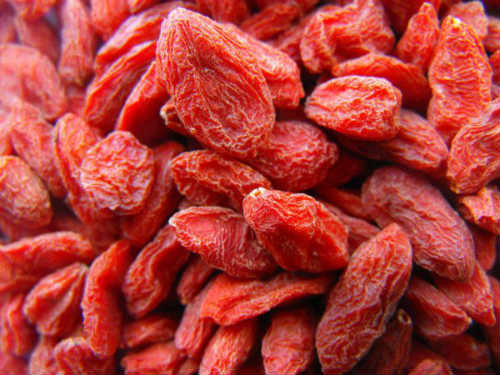

Frozen
In a freezer at a temperature of minus 19 degrees, the berries will quickly turn ice on a pallet, after which they are placed in transparent bags and air is removed.Storage continues only in the freezer.
Jam
1 kg of fruit, 1 kg of granulated sugar, 1 cup of water.
Each housewife has her own way of cooking, but the most delicious jam will turn out if the berries are pre-filled with syrup and allowed to stand overnight. Then boil for a few minutes and leave again overnight. The next cooking will be the final one.
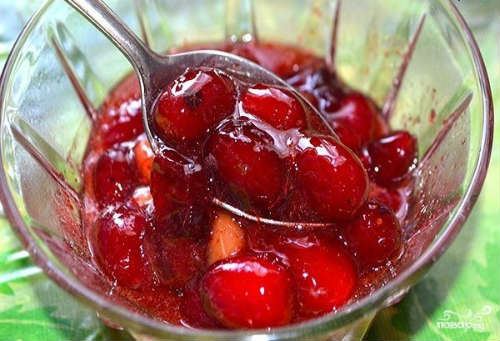

Compote
The preparation is traditional. Sterilized jars, blanching, seaming.
Proportions: 500-600 grams of sugar per half liter of water and 2 grams of citric acid (for better preservation). Delicious sweet berries are suitable for making liqueur. It turns out to be thick, gorgeous in color. Proportion: 1 kg of fruit, 500 grams of sugar, one cup of water, 1 bottle of vodka. The berries are mixed with the rest of the ingredients (sugar - in the form of cold syrup) and infused for 20 days in the dark.
Harvesting of leaves and flowers
For medicinal purposes, boiled dried leaves and flowers are taken. They are brewed like regular tea and drunk throughout the day.
The leaves and color are cut off and dried in natural conditions, after which they are folded into glass containers or cotton bags.
How to properly propagate gumi?
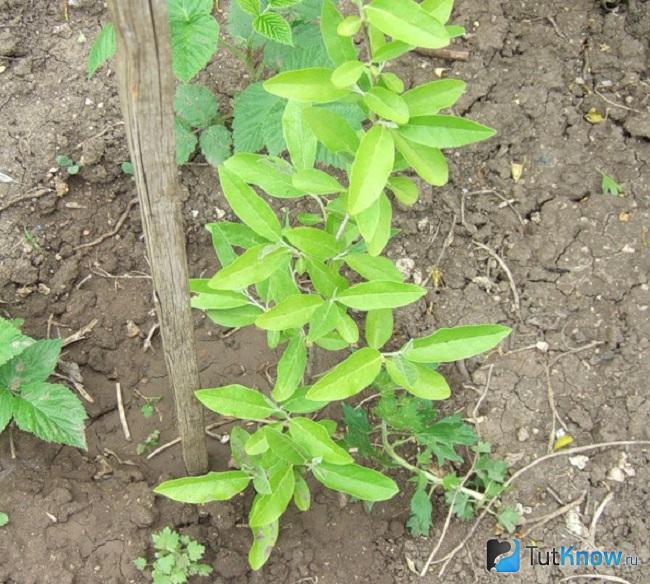

New bushes of multiflora sucker are obtained by sowing seeds or rooting seedlings, layering or cuttings:
- Seed reproduction.
This method is not difficult, but there is a possibility of losing the qualities of gum shrubs. In order not to carry out the stratification of seeds (keeping them for 1-2 months at a temperature of 0-5 degrees), it is recommended to sow them before winter in the autumn months. There they will withstand the cold and will sprout in the spring. If you want to carry out stratification yourself, then its period should be at least 100 days. Seeds are distributed into the prepared soil at a distance of 15–20 cm, sealed and watered. After that, the crops can be covered with a mulch layer, dry foliage or spruce branches. When the snow melts in the spring, the mulch layer is removed and the seedlings are expected to appear. When the seeds germinate (and flower growers argue that the germination of the seeds of the multifloral sucker is rather poor), it is recommended to thin them out, leaving the strongest ones. It is advisable to leave 20-30 cm between the plants. Caring for them consists in regular watering and feeding, as well as shelter for the winter. Often, near the bush, you can find sucker saplings, which were obtained as a result of self-seeding, then they can be carefully dug up and transplanted to another place. But often plants for planting are purchased in nurseries. Such seedlings usually come in transport containers, from which, when planting, you will need to remove the bush. - Cutting gumi.
To root the cuttings, you need to cut the blanks from the green, not lignified side shoots of this year. The length of the blanks is 7–10 cm. If there are leaves at the top, then a couple of them are cut to the middle. For rooting, it is better that the cutting has a heel. The cut of the workpiece is treated with a root formation stimulator (for example, heteroauxinic or naphthylacetic acid) and planted in coarse sand. Then you will need to wrap the seedling with plastic wrap to create conditions for a mini-greenhouse with high humidity. The arrangement of pots with cuttings should be well lit and warm (temperature 20-24 degrees). Maintenance will consist of regular moisturizing and airing. If the rules are followed, rooting takes place in 1.5–2 months. After the seedlings grow up and spend the first winter in rooms, they can be transplanted into open ground with the arrival of heat or change the pot and grow indoors. - Reproduction of gumi by layering.
This operation can be carried out in the fall, when the crop has already been harvested. You need to find shoots in the bush that are not only healthy, but also grow low to the soil surface.On the selected branch, using a sharpened knife, longitudinal cuts are made to remove the bark, but it is important not to damage the inner layer. After that, the "wounds" are treated with Kornevin or another root formation stimulator and pressed to the ground, on which up to 5 cm of rubbed humus is laid. There, the branches are fixed with a rigid wire and sprinkled with soil mixture. If the shoot does not lend itself too much, it is slightly pressed with a load, for example, a brick wrapped in a cloth, until the layering begins to press tightly against the substrate on its own. It is recommended to keep the soil poured onto the cuttings in a moist state so that root shoots appear faster. Already with the arrival of a new growing season at the end of May days or early summer, you can carefully separate the layers from the mother plant of the multifloral sucker. The rooted branch is cut with a secateurs and divided into seedlings so that each of them has a sufficient number of roots. But, despite the presence of a root system, it is recommended to grow gumi seedlings in separate garden containers (pots) until the roots completely fill the container. When growing, it is necessary to provide shading. Only after a year can the seedlings be transplanted into open ground.
Reproduction methods
The most popular breeding methods for gumi are: rooting, layering, planting seeds, cuttings.
Seeds
First, you need to collect ripe seeds. It is recommended to plant them immediately, otherwise they will die. If this is not possible, the seeds should be placed in a slightly damp cloth and sent to the refrigerator.
After sowing, gumi seeds are in the ground, as a rule, up to 4 years, after which they give the first shoots.
Vegetative
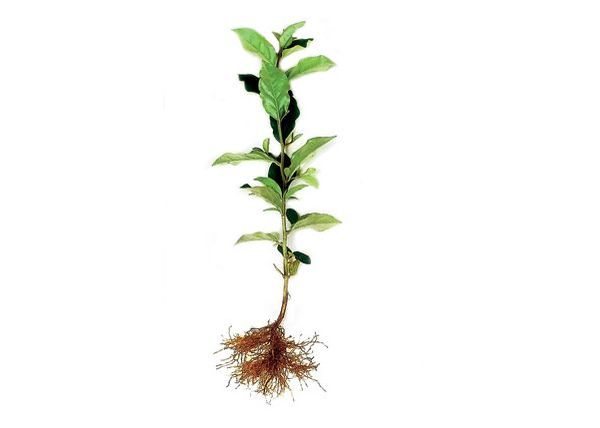

One year old gumi seedling
This breeding method should be started in June. It is necessary to cut off a 10 cm long stalk from an adult plant. The stalk should be placed in a special solution, which accelerates the formation of roots. Next, the cuttings are sent to a substrate of peat, sawdust or compost. It is important to comply with the necessary climatic conditions: humidity - up to 98%, temperature - 30 ° C. To accelerate the growth of new leaves, you can arrange a greenhouse for the plant.
Difficulties and overcoming them when growing a gumi plant
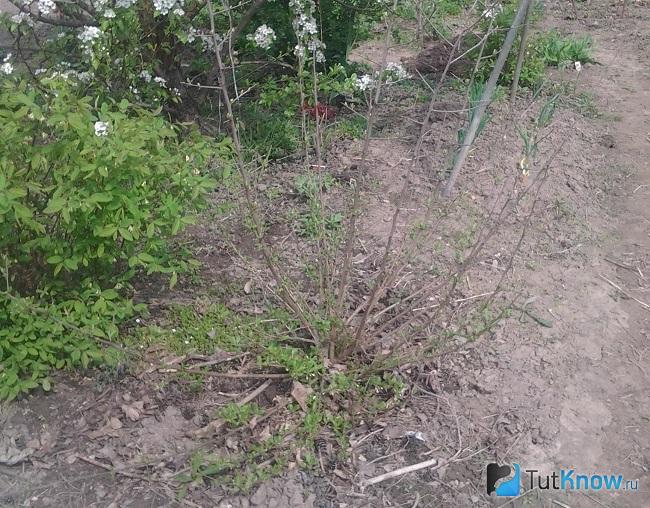

Winds are a real problem when caring for multiflower sucker, so it is recommended to find a leeward place with protection from drafts. Freezing is a problem, which can occur from a sharp drop in temperature during precipitation (rain or snow) and strong winds. However, the plant with the subsequent favorable growing season can recover, the shoots grow back from the root.
You can please gardeners with the fact that in our latitudes, when growing gum, the bushes are not damaged by diseases or pests.
Berry bush care rules
The plant is quite unpretentious, therefore it does not need careful care. However, some rules should still be followed:
- Watering. Since this is a drought-resistant crop, it does not need frequent moisture. Only young seedlings should be watered regularly. Once the ground is dry, the plant needs to be watered. One watering will take about 30-40 liters of water.
- Mulch. Loch multiflorous needs regular soil mulching. Dry grass, humus or sawdust are great for this.
- Pruning. Sanitary pruning is required every year. During the procedure, diseased, damaged, dry or too long branches are removed.
Curious notes about gum
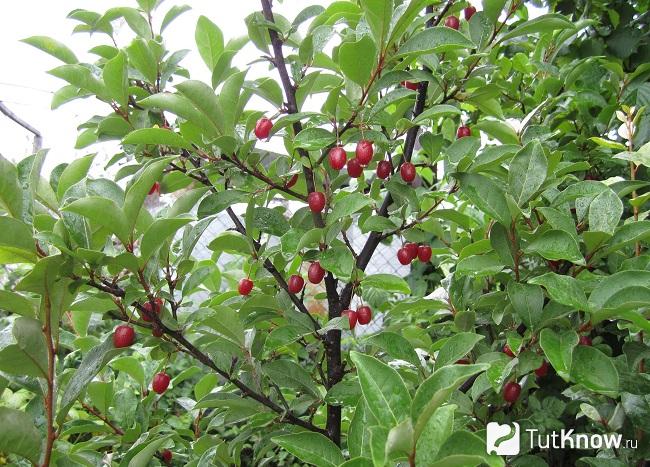

In the lands of China and Japan, fruits are called "miracle berries" because they are rich in amino acids, which are essential for the normal functioning of the human body. Gumi fruits have vitamin C, which surpasses even apples, can not only tone up, but also have an anti-inflammatory effect.The presence of micro- and macroelements in fruits allows you to strengthen the body and improve blood circulation. Elderly patients with diabetes, hypertension and weakened immunity need to take several berries daily. Also in Japan there is an opinion that the use of "miracle berries" will contribute to a person's longevity, and will also help to prolong his youth.
It is customary for the Japanese to improve the cardiovascular system and the gastrointestinal tract with the fruits of the multifloral sucker. These berries are especially good as a vitamin and mineral supplement, which is recommended even for young children.
Vitamins are found not only in gum fruits, there are many of them in the leaves, stems and even the root system. Folk healers prepare decoctions based on foliage, which are recommended for fever and cure colds. If poultices or lotions are made from the leaf plates of the multifloral loch, they will relieve the symptoms of sciatica, relieve pain arising from rheumatism or gout. A decoction of gumi roots improves the functioning of the cardiovascular system.
It is curious that because of the nodules that grow on the roots of the multiflorous sucker, the soil next to the bushes is healed, since the bacteria saturate the soil mixture with nitrogen.
Gumi varieties
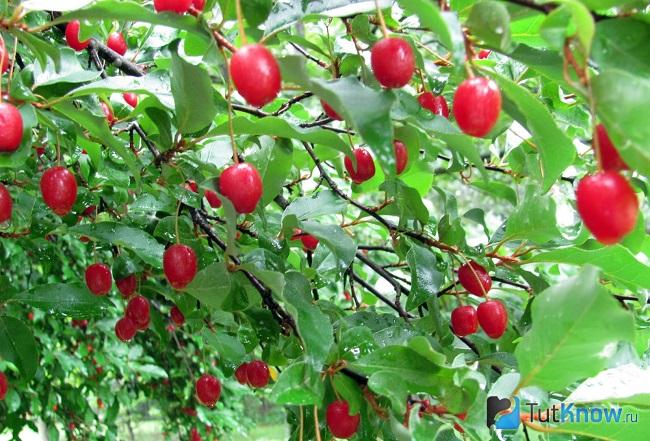

Since only the species of multifloral sucker is used to obtain fruits, the most popular plant varieties are given here.
- Sakhalin First.
The bush has medium-sized shoots and a medium-spreading crown. Shoots are not long, upright. While the branches are young, they are covered with dark green or brownish-red bark; as they mature, they become dark brown or grayish, devoid of pubescence. Thorns can be seen at the bottom of the branches. The thorns are medium in length, thin, their number is large, the color is light. At the top of the branches, the thorns have the same shade, but become double. The foliage surface is bare, matte, dense to the touch, smooth under the toes, with a slight bulge. The edge of the leaf plate has short sharp teeth that do not bend down. At the base, the sheet is straight, but there is a middle notch. The leaf plate itself is divided into 5–7 lobes, formed by deep cuts, the lobes have a pointed tip at the top. When blooming, medium-sized flowers appear with pale pink petals. The fruits ripen quite early. The shape of the fruit is ovoid, the color is red. The skin is of medium density. The taste of the berries is sweet and sour, bringing refreshing. The berry mass reaches 1.4 grams on average. - Crillon -
plant with late ripening of fruits. The size of the fruits is medium, their shape is cylindrical. The skin color is bright red, the taste is sweet and delicate, with a little astringency. The berry has no aroma. This variety is distinguished by a high content of vitamin C in fruits, so in 100 grams of berries its average weight reaches 111 mg. If we compare with apples of the Antonovka variety, then in 100 g this figure ranges from 7-13 mg. The skin of the fruit is thin and glossy, covered with a pattern of specks of a silvery-white tone. The fruit stem of the berries is green, elongated. Shrub with average height and crown spreading. The branches are upright, their surface is dotted with multiple lenticels. A small number of medium-sized thorns can be found only in the lower part of the shoots. Foliage whole-edged, elongated with a pointed tip. The color of the leaves is green, on the back there are lentils. The foliage is naked, leathery, shiny, has a strong concavity. When blooming, medium-sized flowers open, with a pale color. The variety is winter hardy. - Taisa
or
Taisiya.
The variety allows you to have an early ripening harvest, dessert fruits. The size of the bush is medium, the spreading is small. The color of straight branches is brown, no pubescence.In the lower part, there are short brown thorns on the branches. The foliage is small, the color is dark green. The leaf is glabrous, with a shiny surface, leathery, wedge-shaped at the base. The corolla of the flower is tubular, small. The petals are pale. The shape of the fruit is ovoid or elongated, the color is dark red. The taste of the berries is sweet and sour. The average fruit weight is 1.2 grams. - Moneron.
The fruits have an average ripening period. Shrub with medium spreading and shoot height. The fruits are barrel-shaped, the skin is thin, glossy, covered with silvery-whitish specks. No pubescence. The berries taste sweet, tender, with a little astringency.
Video about growing gumi:
Photos of gum:
Brief botanical description
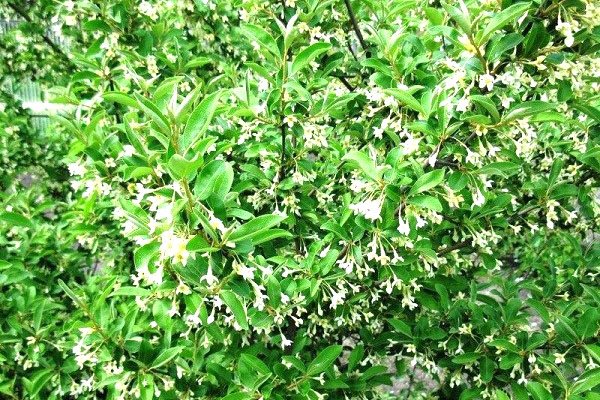

According to the botanical classification, gumi (multiflorous oak) belongs to the Lokhovye family and is a relative of the sea buckthorn. The plant forms a vigorous, branched shrub with flexible prickly shoots. Reaches a height of 1.5-2 meters. During the flowering period, the bush is abundantly covered with numerous fragrant flowers and can serve as a decorative function.
The flowering of the multiflorous oak occurs at the end of May. 1.5 months after pollination, the fruits of gumi ripen - small oval drupes. In the phase of biological ripeness, they have a red skin with light dots and are able to hold out on the bush until frost without shedding. The juicy and transparent pulp has a sour-sweet taste with a slight astringency.
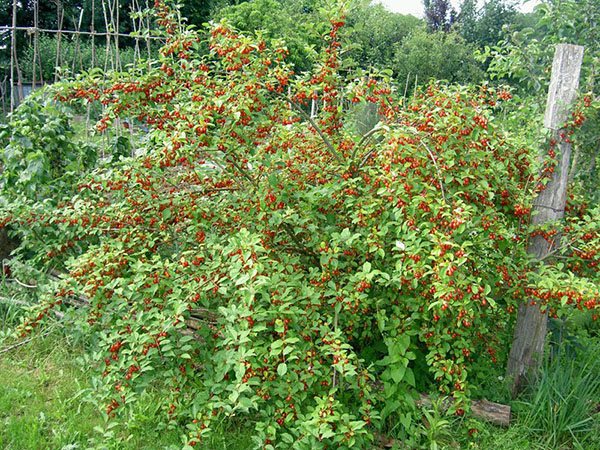

In the East, gumi berries have been used in folk medicine since ancient times. In Russia, they are usually dried or frozen and used for compotes in winter. They are also added to preserves, sauces, jams.
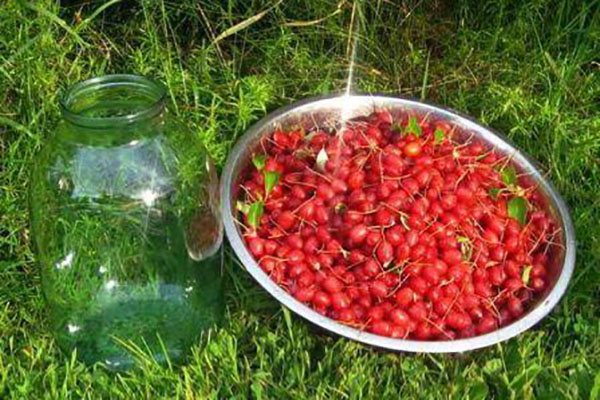

Thus, the multifloral goose can perform several functions on the site:
- decorative;
- melliferous;
- economic.
In regions with mild winters, this shrub is able to exhibit the qualities of an evergreen, retaining its decorative effect throughout the year.
Nitrogen-fixing soil bacteria readily develop on the root system of the multifloral sucker. Therefore, planting this plant can serve to improve the soil on the site.



